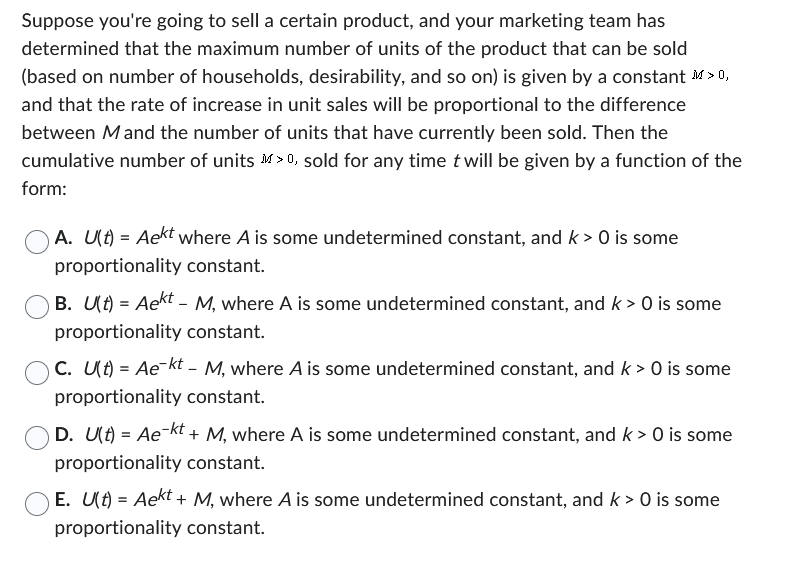Suppose you're going to sell a certain product, and your marketing team has determined that the maximum number of units of the product that can be sold (based on number of households, desirability, and so on) is given by a constant M>0, and that the rate of increase in unit sales will be proportional to the difference between M and the number of units that have currently been sold. Then the cumulative number of units >0, sold for any time t will be given by a function of the form: A. U(t) = Aekt where A is some undetermined constant, and k> 0 is some proportionality constant. B. U(t) = Aekt – M, where A is some undetermined constant, and k > 0 is some proportionality constant. C. U(t) = Ae-kt - M, where A is some undetermined constant, and k > 0 is some proportionality constant. D. U(t) = Ae¯kt + M, where A is some undetermined constant, and k> 0 is some proportionality constant. E. U(t) = Aekt + M, where A is some undetermined constant, and k> 0 is some proportionality constant.
Suppose you're going to sell a certain product, and your marketing team has determined that the maximum number of units of the product that can be sold (based on number of households, desirability, and so on) is given by a constant M>0, and that the rate of increase in unit sales will be proportional to the difference between M and the number of units that have currently been sold. Then the cumulative number of units >0, sold for any time t will be given by a function of the form: A. U(t) = Aekt where A is some undetermined constant, and k> 0 is some proportionality constant. B. U(t) = Aekt – M, where A is some undetermined constant, and k > 0 is some proportionality constant. C. U(t) = Ae-kt - M, where A is some undetermined constant, and k > 0 is some proportionality constant. D. U(t) = Ae¯kt + M, where A is some undetermined constant, and k> 0 is some proportionality constant. E. U(t) = Aekt + M, where A is some undetermined constant, and k> 0 is some proportionality constant.
Algebra for College Students
10th Edition
ISBN:9781285195780
Author:Jerome E. Kaufmann, Karen L. Schwitters
Publisher:Jerome E. Kaufmann, Karen L. Schwitters
Chapter8: Functions
Section8.7: Direct And Inverse Variation
Problem 39PS
Related questions
Question

Transcribed Image Text:Suppose you're going to sell a certain product, and your marketing team has
determined that the maximum number of units of the product that can be sold
(based on number of households, desirability, and so on) is given by a constant M>0,
and that the rate of increase in unit sales will be proportional to the difference
between M and the number of units that have currently been sold. Then the
cumulative number of units >0, sold for any time t will be given by a function of the
form:
A. U(t) = Aekt where A is some undetermined constant, and k > 0 is some
proportionality constant.
B. U(t) = Aekt – M, where A is some undetermined constant, and k > 0 is some
proportionality constant.
C. U(t) = Ae-kt - M, where A is some undetermined constant, and k > 0 is some
proportionality constant.
D. U(t) = Ae¯kt + M, where A is some undetermined constant, and k> 0 is some
proportionality constant.
E. U(t) = Aekt + M, where A is some undetermined constant, and k> 0 is some
proportionality constant.
Expert Solution
This question has been solved!
Explore an expertly crafted, step-by-step solution for a thorough understanding of key concepts.
This is a popular solution!
Trending now
This is a popular solution!
Step by step
Solved in 3 steps with 3 images

Recommended textbooks for you

Algebra for College Students
Algebra
ISBN:
9781285195780
Author:
Jerome E. Kaufmann, Karen L. Schwitters
Publisher:
Cengage Learning

Algebra and Trigonometry (MindTap Course List)
Algebra
ISBN:
9781305071742
Author:
James Stewart, Lothar Redlin, Saleem Watson
Publisher:
Cengage Learning

Algebra for College Students
Algebra
ISBN:
9781285195780
Author:
Jerome E. Kaufmann, Karen L. Schwitters
Publisher:
Cengage Learning

Algebra and Trigonometry (MindTap Course List)
Algebra
ISBN:
9781305071742
Author:
James Stewart, Lothar Redlin, Saleem Watson
Publisher:
Cengage Learning